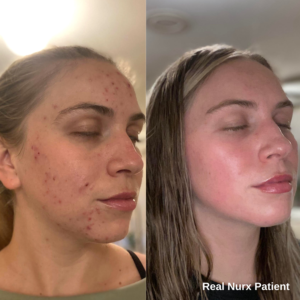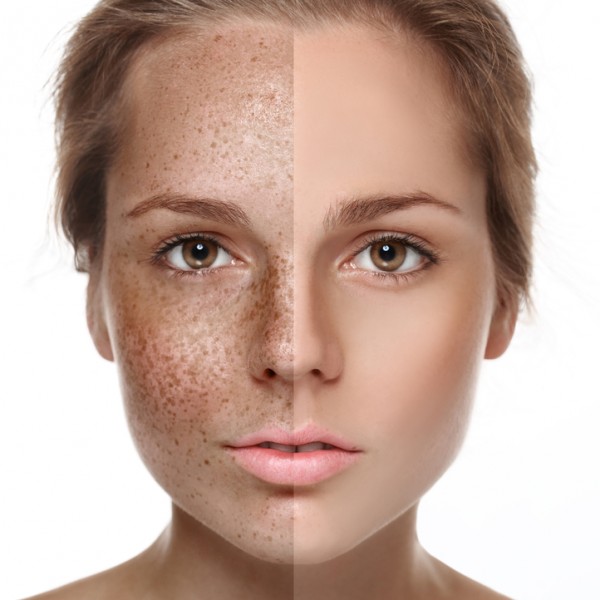Hyperpigmentation
Hyperpigmentation is frequent skin issue that affects people of all ages and skin types is hyperpigmentation. For many people, hyperpigmentation which can be brought on by sun damage, acne scars, hormone changes, or other factors can be upsetting and generate self-consciousness. Thankfully, there are a lot of therapy choices to aid with this problem, and tretinoin, a vitamin A derivative, is one of the best one. This article aims to demonstrate the extraordinary potential of tretinoin by examining its mechanism of action against hyperpigmentation and offering a thorough before and after study.
What is Hyperpigmentation
A common skin issue called hyperpigmentation is characterized by patches of darker skin. Before to discussing how tretinoin treats hyperpigmentation, it’s critical to comprehend what hyperpigmentation is and how it develops. the term hyperpigmentation describes the darkening of specific skin regions brought on by an overabundance of melanin, the pigment that gives our skin, hair, and eyes their color. This illness can present itself in several ways, such as:
Sun spots: Also called age spots, liver spots, or solar lentigines, they are pigmentation patches that result from extended sun exposure. Usually, they appear on the hands, cheeks, and other places that are frequently exposed to the sun.

Often referred to as the “mask of pregnancy,” this hormonally-related skin condition primarily affects women. Large, asymmetrical areas of gray-brown or brown pigmentation appear on the face as a result.
Post-Inflammatory Hyperpigmentation (PIH)
This kind of hyperpigmentation develops following burns, wounds, or other skin injuries. Where the wound was, dark streaks or patches appear.
Tretinoin: An Effective Treatment for Excessive Pigmentation
Tretinoin, often known as Retin-A, is a topical drug that is a member of the retinoid family. It is well renowned for being able to effectively treat a variety of skin conditions, including hyperpigmentation. Tretinoin combats hyperpigmentation in a few different ways.
Cell Turnover: Tretinoin quickens skin cell turnover. This indicates that it encourages the production of new, healthier skin cells and the shedding of old, pigmented skin cells. Over time, this procedure aids in the fading of hyperpigmented areas.
Collagen Production: Tretinoin encourages the skin’s natural production of collagen. Maintaining the firmness and suppleness of the skin depends on collagen, and as it is generated, It may aid in enhancing the skin’s tone and texture.
Even Skin Tone: Tretinoin aids in the creation of a more even skin tone by stimulating cell turnover and new skin cell formation. This makes it very useful for treating conditions like melasma and sunspots.
Trtretinoin’s Effect on Hyperpigmentation: Before and After
In order to fully understand how tretinoin can significantly reduce hyperpigmentation, let’s examine a few before and after examples:
Age spots and sunspots
Before: Sarah, a 45-year-old lady, had obvious sunspots on her hands and face, most likely from years of sun exposure without wearing sunscreen.
After: Sarah’s complexion looked more youthful and radiant, and her sunspots had significantly disappeared after using tretinoin for six months. She appeared years younger due to the uniformity of her skin tone.

Glaucoma
Before to: Maria, a 35-year-old lady, suffered from forehead and cheek melasma patches. She had felt self-conscious about these patchy spots of pigmentation.
After: After using tretinoin consistently for a year, Maria’s melasma patches had considerably lessened. She claimed to be less dependent on thick makeup to hide the issue and to feel more confident.
Hyperpigmentation after Inflammation (PIH)
Before: Mark, a 25-year-old man, suffered from acne and had dark patches left over from prior outbreaks. He felt self-conscious about his appearance because of these marks.
After: Mark’s skin looked much different from his before and after pho appeared to have been using tretinoin for six months, his skin was substantially smoother and the post-inflammatory hyperpigmentation had diminished.
Important Factors to Consider and Advice:
Although tretinoin has shown to be an effective treatment for hyperpigmentation, there are a few crucial factors and advice to remember:
- See a Dermatologist: before to beginning any tretinoin treatment, it is imperative that you see a dermatologist. They are able to determine your skin type, recommend the right tretinoin strength, and offer usage advice.
- Tretinoin takes time to produce effects, thus patience is essential. It’s critical to administer the medicine consistently and with patience. It can take a few weeks to observe any real progress.
- Sun Protection: Vigilant sun protection is required to stop further hyperpigmentation and to improve tretinoin’s efficacy. This entails limiting sun exposure and using a sunscreen every day.
- Control Side Effects: Dryness, redness, and peeling are a few of the transient side effects that retinoin may induce. These can be controlled by applying a high-quality moisturizer and adhering to your dermatologist’s advice.
- Protection from the Sun: Even on overcast days, use sunscreen with at least SPF 30 every day. Make use of broad-spectrum sunscreen to ward off UVA and UVB radiation. When you’re outside, reapply sunscreen every two hours. When in the sun, put on protective gear like sunglasses and hats with wide brims.
- Avoid Being in the Sun: Attempt to avoid the sun between the hours of 10 a.m. and 4 p.m. When spending time outside, look for shade.
- Sunblock with iron oxide: Certain sunscreens containing iron oxide may offer supplementary defense against visible light, which may exacerbate hyperpigmentation.
- Antioxidants Topical: Utilize antioxidant-rich skin care products, such as vitamin C, to help shield your skin from damage brought on by free radicals.
hyperpigmentation can be a troubling skin condition that negatively affects their general well-being and sense of self. Tretinoin is a topical retinoid that has become a potent treatment for hyperpigmentation because it encourages the creation of collagen, cell turnover, and even skin tone. The extraordinary ability of tretinoin to improve skin tone and increase self-confidence is demonstrated by the before and after stories of those who have taken it.
however it’s crucial to keep in mind that tretinoin is a prescription drug and needs to be used under a dermatologist’s supervision. To fully benefit from this treatment, consistency, patience, and sun protection are essential. Tretinoin has the potential to significantly improve skin clarity and brightness while addressing hyperpigmentation issues if used properly.
